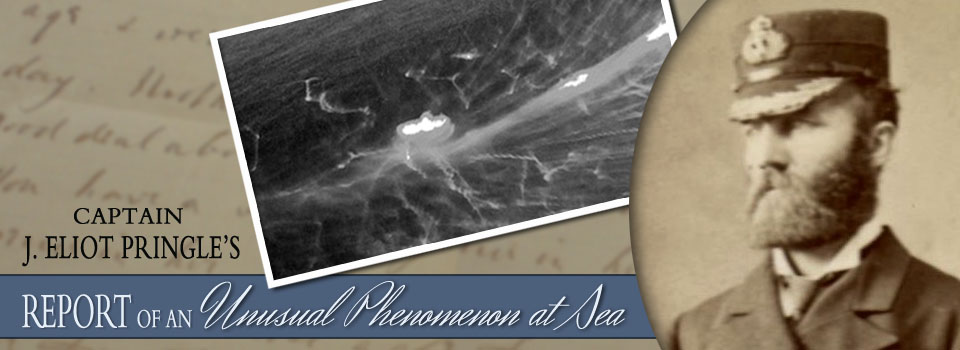Report of an Unusual Phenomenon at Sea
This report was sent to the Admiralty by Capain J. Eliot Pringle (H.M.S. Vulture) in 1879 and holds the distinction of being the first known report of what is called a "Marine" or "Submarine Lightwheel". Still a mystery, lightweels are almost only seen in the Indian Ocean, South China Sea and Persian Gulf — but they are always reported in the proximity to the latitude of 19.5 degrees. It is agreed that these phenomena certainly have something to do with bioluminescent organisms, but the specific elements involved in creating a lightwheel are still undetermined.
H.M.S. Vulture, Bahrein, May 17, 1879
Sir— I have the honour to inform you that, at about 9:40pm on May 15, when in lat. 26* 26' N. and long 53* 11' E., a clear, unclouded, starlight night, Arcturus being within some 7* of zenith, and Venus about to set; wind north-west, force 3, sea smooth, with slight swell from the same direction; ship on starboard tack, heading west-south-west and going three knots, an unusual phenomenon was seen from the vessel.
I noticed luminous waves or pulsations in the water, moving at great speed and passing under the ship from the south-south-west. On looking towards the east, the appearance was that of a revolving wheel with centre on that bearing, and whose spokes were illuminated, and looking towards the west a similar wheel appeared to be revolving, but in the opposite direction. I then went to the mizen top (fifty feet above water) with the first lieutenant, and saw that the luminous waves or pulsations were really travelling parallel to each other, and that their apparently rotatory motion, as seen from the deck, was caused by their high speed and the greater angular motion of the nearer than the more remote part of the waves. The light of these waves looked homogeneous, and lighter, but not so sparkling, as phosphorescent appearances at sea usually are, and extended from the surface well under water; they lit up the white bottoms of the quarter-boats in passing. I judged them to be twenty-five feet broad, with dark intervals of about seventy-five between each, or 100 from crest to crest, and their period was seventy-four to seventy-five per minute, giving a speed roughly of eighty-four English miles an hour.
From this height of fifty feet, looking with or against their direction, I could only distinguish six or seven waves; but, looking along them as they passed under the ship, the luminosity showed much further.
The phenomenon was beautiful and striking, commencing at about 6h. 3m. Greenwich mean time, and lasting some thirty-five minutes. The direction from which the luminous waves travelled changed from south-south-west by degrees to south-east and to east. During the last five minutes concentric waves appeared to emanate from a spot about 200 yards east, and these meeting the parallel waves from south-east did not cross, but appeared to obliterate each other at the moving point of contact, and approached the ship, inclosing an angle about 90*. Soundings taken in twenty-nine fathoms; Stiffe's Bank, with fifteen to twenty fathoms, being west about one mile. The barometer was already at 29'25 from 8 to 12pm.
Temperature of Air . . . At 8:00pm: 84 . . . At 10:15pm: 83 . . . At Midnight: 83
Temperature os Sea Water . . . At 8:00pm: 84 . . . At 10:15pm: 82 . . . At Midnight: 82
I observed no kind of change in the wind, the swell, or in any part of the heavens, nor were the compasses disturbed. A bucket of water was drawn, but was unfortunately capsized before daylight. The ship passed through oily-looking fish spawn on the evening of the 15th and morning of the 16th inst.—
I have the honour to be, Sir, your obedient servant,
J. Eliot Pringle, Commander

